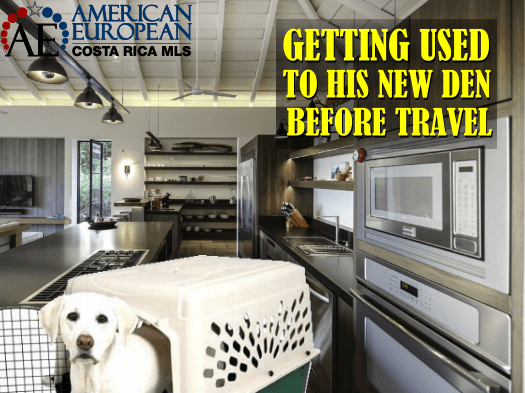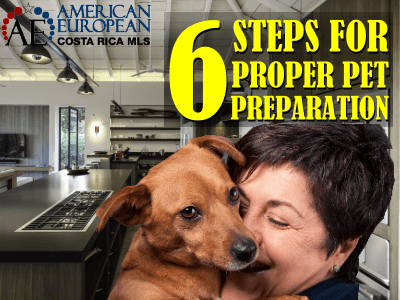Angela Passman, a long-time supporter of the American European real estate network wrote an interesting article about proper pet travel on her Linkedin account. Thank you for allowing to use your article, Angela!
Flying with your dog can be stressful and proper pet travel is important. Here is a 6-step checklist to prepare for property pet travel and keep the stress level down for both you and your dog.
1. Bring a Kennel
First and foremost, for proper pet travel, buy an airline-approved crate. Be sure that your dog thinks of this crate as his den. You may need to spend time getting your dog comfortable with being in his crate for long periods of time. There will also be a lot of loud noises on the plane and strange people walking around in the cargo-loading area.

To prepare him for proper pet travel, place your dog in the kennel and try carrying him in it by taking a drive to a park or busy location. This way, your dog can get used to loud noises and a busy environment while being handled inside his crate.
2. Outfit the Crate
There are certain items that you will want to place on the outside and inside of the crate for proper pet travel:
On the outside of the crate, attach a few bright orange stickers that read “LIVE ANIMAL.” Most airlines will do this as protocol. But it doesn’t hurt to have them on the crate before you arrive at the airport.
Include a typed one-page profile of your dog that includes your contact information, including your cell phone number.
Make sure water and food dishes are attached to the inside of the crate.
Tape a small bag of food and a leash to the top of the crate.
3. Flight Time
To avoid plane changes or delays, check the length of the flight and try to book a direct flight when possible. It is important to match the length of the flight with your dog’s temperament and what you know he can handle.
Whether your dog is being shipped as cargo or is riding in the cabin will help determine his experience during the flight.
4. Health Clearance
Before taking off, get a clean-bill-of-health certificate from your veterinarian. Your dog cannot fly without veterinarian records stating he is in good health. Airlines around the world require a certificate that is dated no more than 10 days before your departure date.
If the health certificate is endorsed (as in the USA by USDA, APHIS, VS) the date your pet was originally seen by your veterinarian is when the 10-day count begins, NOT the date of the endorsement by the government agency.
5. Exercise a Go-go
Every dog has a different energy level. A young Labrador runs on high octane and will need to expend this energy before being cooped up in his kennel for a long flight. An airport with an onsite dog area is a perfect place to play with your dog before placing him in his crate. This will also give him a good chance to relieve himself before the flight. For property pet travel, stay away from sedatives.
The American Veterinary Medical Association (AVMA) and the Independent Pet and Animal Transportation Association (IPATA) say that sedation could lead to injury if your dog’s crate moves during the flight and your dog is not able to brace itself. The increased altitude may further cause respiratory and cardiovascular problems for sedated animals.
6. Nervous Nelly
You have decided to make the flight with your dog. But sometimes no matter how safe something seems, you may feel nervous sending your dog down into the belly of the plane. Even though you know the probability of nothing happening to him is in your favor, the separation and inability to see what his environment is like can be unnerving.

A Few More Tips
For proper pet travel, here are a few ways for both of you to keep your cool:
a) Give plenty of reassuring hugs and kisses to your dog. When you are calm and confident, your pet will follow your lead and realize there is nothing to worry about. If you’re emotional about the separation and the trip, your pet may pick up on it and become concerned about the adventure.
b) Keep the mood light with a little pre-flight play to relieve any tension.
c) If your dog is in cargo, ask the flight attendant to confirm that your dog is loaded and secure once you’re on board. They may be able to give your dog a little extra water in his dish before take-off.
d) Taking the extra time to become mentally and practically prepared for a trip involving extra logistics will make all the difference to you and your dog.
Looking for a pet-friendly property in Costa Rica? Then click here.
The Author
Angela Passman is the owner of World Pet Travel, an International Pet Transportation company since 1998. She started up in New York before transferring to San Jose, Costa Rica right after 9-11. World Pet Travel is an expert liaison between multiple countries government authorities, airlines, veterinarians and clients. You can email Angela at angela@movepet.com



















